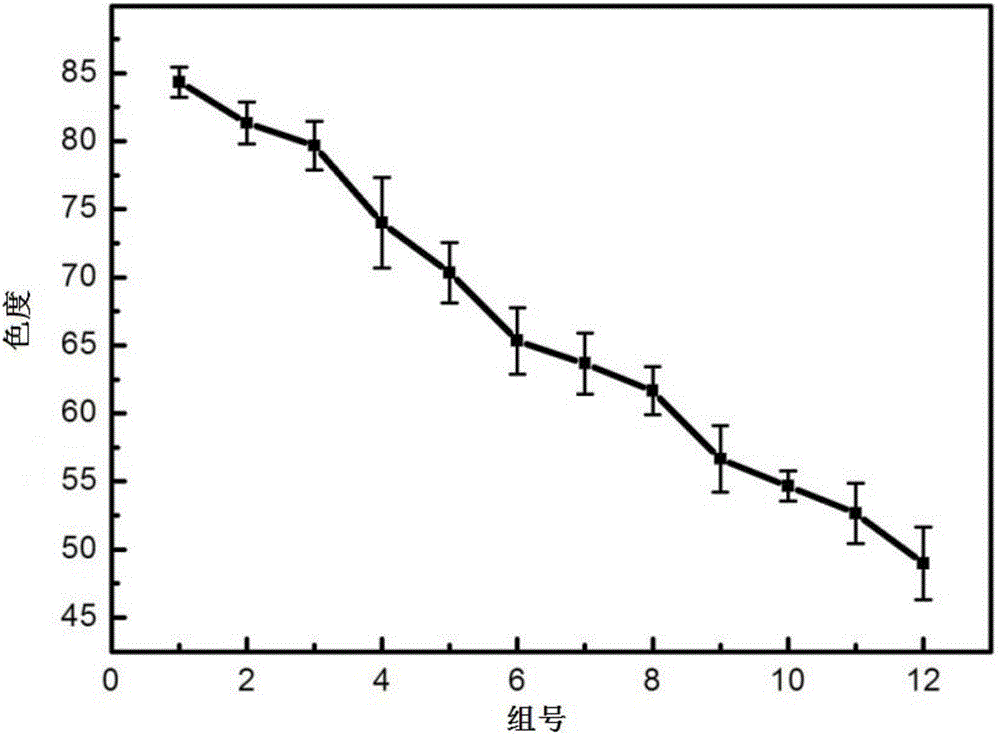Pesticide residue detection method and detection kit
A pesticide residue detection and kit technology, which is applied in chemical analysis by titration, material analysis by observing the impact on chemical indicators, instruments, etc., can solve the problems of unrecyclable, expensive tool enzymes, and high detection costs , to achieve the effect of easy observation, easy operation and high sensitivity
- Summary
- Abstract
- Description
- Claims
- Application Information
AI Technical Summary
Problems solved by technology
Method used
Image
Examples
Embodiment 1
[0064] This embodiment provides a method for making pesticide residue detection test paper, which specifically includes the following steps:
[0065] S1. Weigh 30 grams of silk, and the molar concentration is 0.02 Na 2 CO 3 Boil in an aqueous solution for 30 minutes, wash with deionized water, place in a fume hood to air-dry, place in lithium bromide with a molar concentration of 9.3, dissolve at 60 degrees for 4 hours to become a silk fibroin solution. Put the silk fibroin solution into a dialysis bag, dialyze in deionized water for 36 hours, change the water 6 times during the period; centrifuge to remove impurities, and dilute the obtained silk fibroin aqueous solution to a concentration of 4%;
[0066] S2. Take 2ml of silk fibroin solution and place it in an ultrasonic cell pulverizer. The ultrasonic power is 20-40%, and the ultrasonic time is 1-10 minutes. The ultrasonic power is preferably 30%, and the time is preferably 3-4 minutes; add acetylcholine therein Esterase,...
Embodiment 2
[0069] This embodiment adopts the test paper-enzyme-silk fibroin film provided in the first embodiment, and provides a method for detecting pesticide residues, which specifically includes the following steps:
[0070] S1. Take 50 μL of different concentrations of pesticides and 900 μL of disodium hydrogen phosphate-potassium dihydrogen phosphate buffer pH=8 with a concentration of 0.1mol / L and pH=8.0, and add them to the test paper-enzyme-silk fibroin In the protein-filmed 24-well plate, add 50 μL of paraoxon pesticides with concentrations of 0, 0.002, 0.02, 0.2, 1, 2, 4, 10, 20, 1000, and 200 mg / L into different wells, at 37°C Incubate for 15 minutes
[0071] S2. After the membrane is completely wetted, add 50 μL of acetylcholine solution with a concentration of 0.2 mol / L to each well, and react at 37°C. After 30 minutes, check the color of the test paper. figure 1 As shown, the concentration of pesticides added in the figure is 0, 0.002, 0.02, 0.2, 1, 2, 4, 10, 20, 1000, 20...
Embodiment 3
[0073] This embodiment adopts the test paper-enzyme-silk fibroin film provided in the first embodiment, and provides a method for detecting pesticide residues in fruits and vegetables, including the following steps:
[0074] S1. Grind the vegetables to be tested stained with pesticides, take a certain amount and add them to the centrifuge tubes respectively, and then add a certain amount of phosphate buffer solution with a concentration of 0.01-0.1mol / L to the centrifuge tubes. Shake for 10 minutes;
[0075] S2. Take out the mixed solution, add it to the prepared test paper-enzyme-silk fibroin film, and incubate at 37°C for 15 minutes;
[0076] S3. After the membrane is completely wetted, add acetylcholine solution, react at 37°C, and compare the color with the standard color card after 10 to 30 minutes.
[0077] The present invention takes cabbage contaminated with pesticides of different specific concentrations as an example to describe in detail, and the specific steps are...
PUM
 Login to View More
Login to View More Abstract
Description
Claims
Application Information
 Login to View More
Login to View More - R&D
- Intellectual Property
- Life Sciences
- Materials
- Tech Scout
- Unparalleled Data Quality
- Higher Quality Content
- 60% Fewer Hallucinations
Browse by: Latest US Patents, China's latest patents, Technical Efficacy Thesaurus, Application Domain, Technology Topic, Popular Technical Reports.
© 2025 PatSnap. All rights reserved.Legal|Privacy policy|Modern Slavery Act Transparency Statement|Sitemap|About US| Contact US: help@patsnap.com



